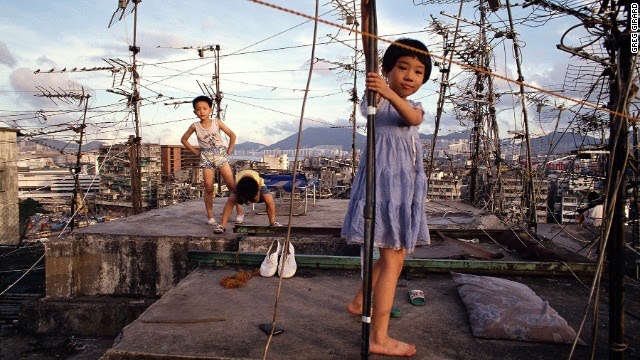Kowloon walled city with 33,000 peoples living in 2.6 hectare area in more than 300 interconnected high-rise buildings, all constructed without contributions from a single architect.
Population Density : 1,255,000 people per square Kilo-meter.
 |
| Kowloon City 300 Buildings |
Kowloon Walled City's early population fluctuated between zero and a few hundred, and began growing steadily shortly after World War II. However, there is no accurate population information available for much of the Walled City's later existence. Official census numbers estimated the Walled City's population at 10,004 in 1971 and 14,617 in 1981, but these figures were commonly considered to be much too low. Informal estimates, on the other hand, often mistakenly included the neighbouring squatter village of Sai Tau Tsuen. Population figures of about 50,000 were also reported.
 |
| Kowloon City Lit up at Night |
A thorough government survey in 1987 gave a clearer picture: an estimated 33,000 people resided within the Walled City. Based on this survey, the Walled City had a population density of approximately 1,255,000 inhabitants per square kilometre (3,250,000/sq mi) in 1987.
The Walled City was located in what became known as the Kowloon City area of Kowloon,Hong Kong). In spite of its transformation from a fort into an urban enclave, the Walled City retained the same basic layout. The original fort was built on a slope and consisted of a 2.6-hectare (0.010 sq mi) plot measuring about 210 by 120 metres (690 by 390 ft). The stone wall surrounding it had four entrances and measured 4 metres (13 ft) tall and 4.6 metres (15 ft) thick before it was dismantled in 1943.
 |
| TV antennas at the rooftop of Kowloon City Buildings |
The City's dozens of alleyways were often only 1–2 m (3.3–6.6 ft) wide, and had poor lighting and drainage. An informal network of staircases and passageways also formed on upper levels, which was so extensive that one could travel north to south through the entire City without ever touching solid ground. Construction in the City went unregulated, and most of the roughly 300 buildings were built with poor foundations and few or no utilities. Because apartments were so small — a typical unit was 23 m2 (250 sq ft) — space was maximised with wider upper floors, caged balconies, and rooftop additions. Roofs in the City were full of television antennas, clothes lines, water tanks, and rubbish, and could be crossed using a series of ladders.
 |
| Shops in Kowloon City |
No comments:
Post a Comment